Hello Hivers.
☺☺☺
A few days ago I was given some mangoes and they were very ripe, so much so that their smell was quite strong, so we decided to make a juice and I remembered that beetles like the sweetness of very ripe fruits, so I took the peels to the patio hoping that the smell would attract some kind of insect to photograph it.

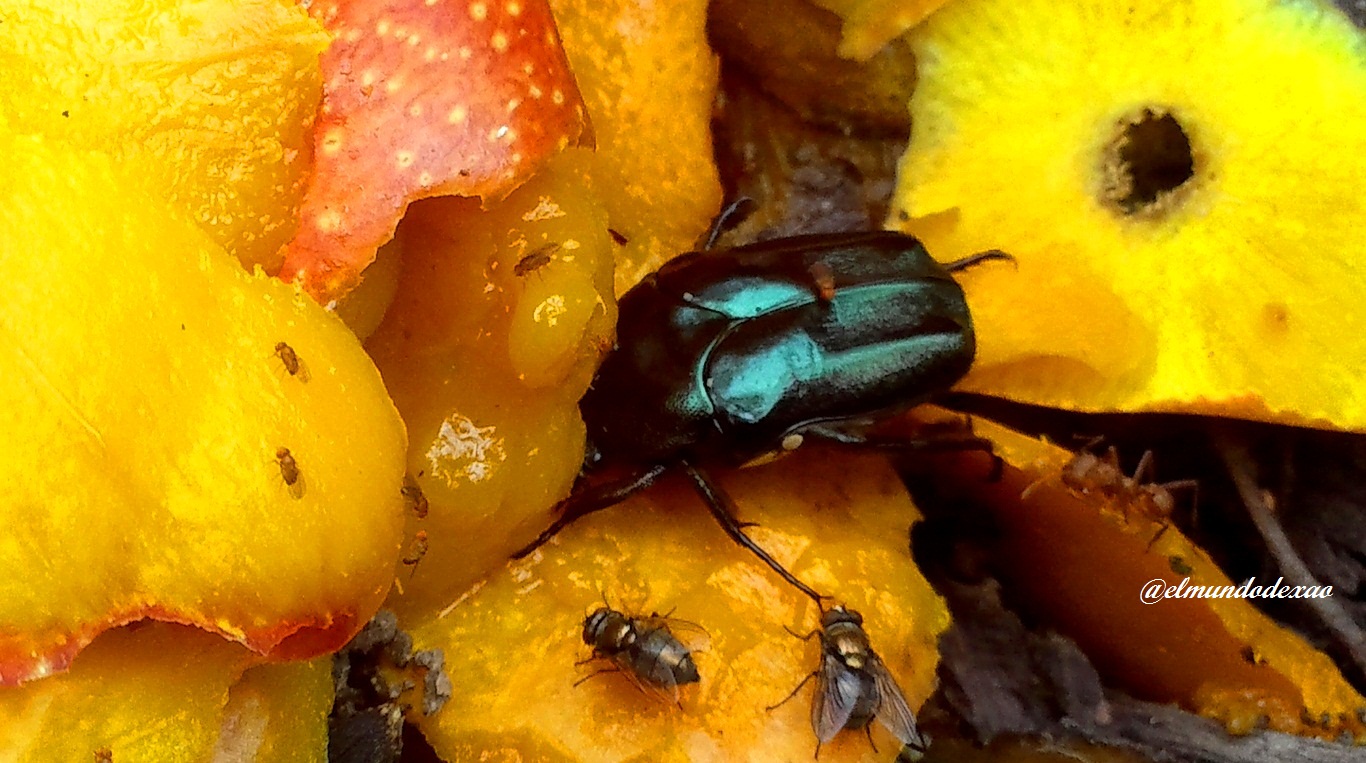 After a while we saw a flying insect circling in that place, we all agreed that it was a green hornet of those that are dangerous and throw an irritating substance by the sting, so we proceeded with caution to approach because if it really was one of those we could not approach for obvious reasons.
After a while we saw a flying insect circling in that place, we all agreed that it was a green hornet of those that are dangerous and throw an irritating substance by the sting, so we proceeded with caution to approach because if it really was one of those we could not approach for obvious reasons.
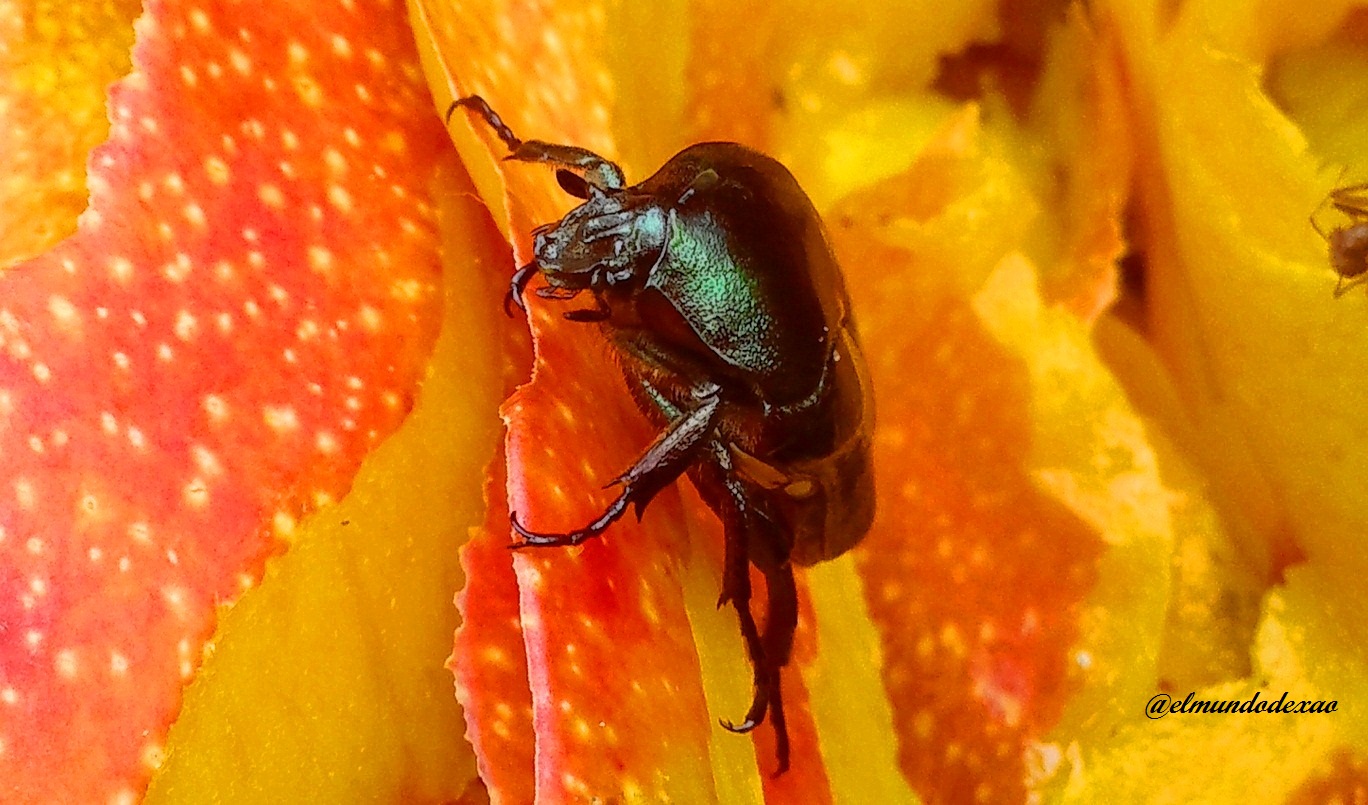
 Many insects are attracted by the molasses or candy of decaying fruit so it was almost certain that I would have a photo for my publication; when we got closer we managed to see that it was not a green hornet but a translucent beetle that I had never seen so I got very excited, I started to take some pictures but my parents told me not to get too close because this type of beetle is not like the ones that come at night to the house. This is a diurnal beetle so it is quicker to fly and is very suspicious, as soon as it detects danger it flies away.
Many insects are attracted by the molasses or candy of decaying fruit so it was almost certain that I would have a photo for my publication; when we got closer we managed to see that it was not a green hornet but a translucent beetle that I had never seen so I got very excited, I started to take some pictures but my parents told me not to get too close because this type of beetle is not like the ones that come at night to the house. This is a diurnal beetle so it is quicker to fly and is very suspicious, as soon as it detects danger it flies away.
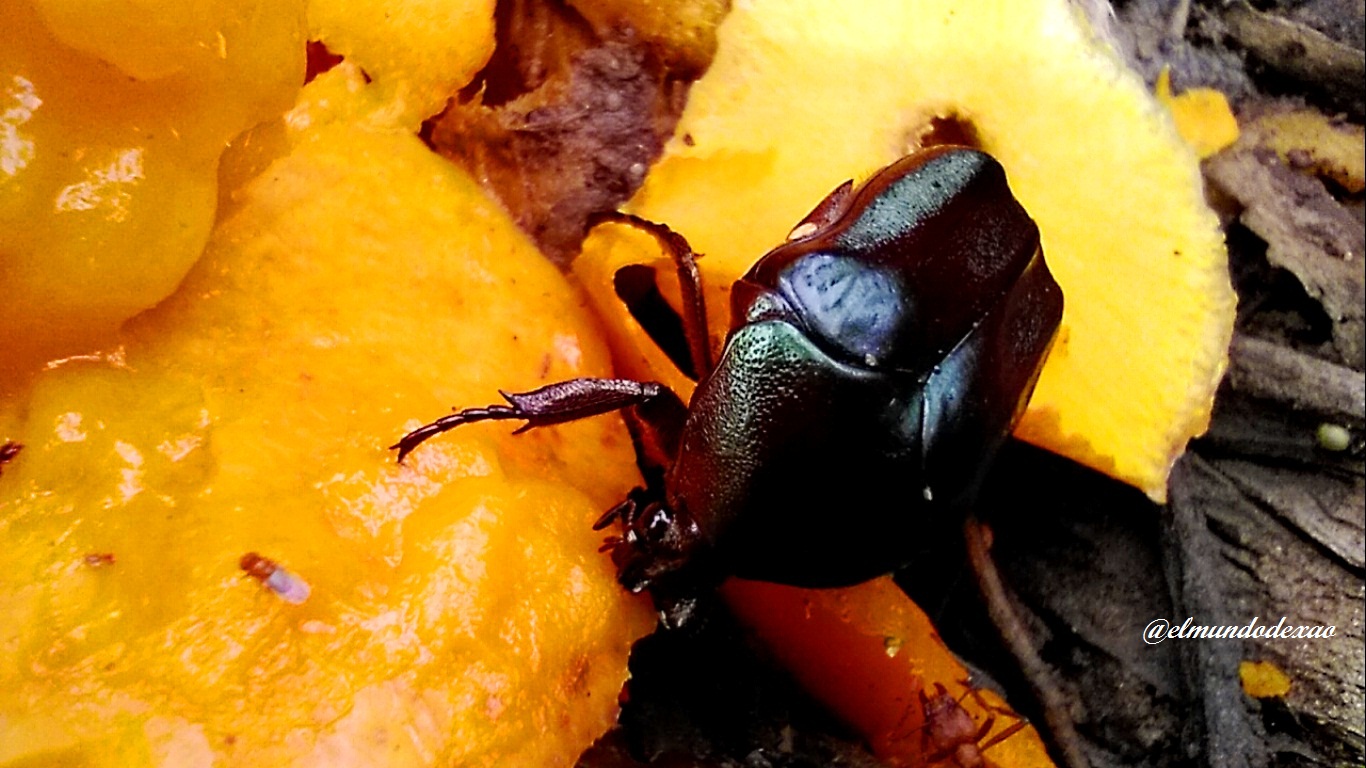
 I approached slowly and apparently the banquet was too succulent for the beetle since it did not pay attention to me at any time, so much so that I was able to take macro photographs and not even disturb its moment of satisfaction. Something that I could notice is that I have published some that have horns, others with strong jaws and others that are characterized by having antennae much larger than its body; but when I observed this one carefully I realized that it does not have any of these characteristics. That is to say, one of the basic things that we must learn is to pay attention to details, since in countless occasions they are very important.
I approached slowly and apparently the banquet was too succulent for the beetle since it did not pay attention to me at any time, so much so that I was able to take macro photographs and not even disturb its moment of satisfaction. Something that I could notice is that I have published some that have horns, others with strong jaws and others that are characterized by having antennae much larger than its body; but when I observed this one carefully I realized that it does not have any of these characteristics. That is to say, one of the basic things that we must learn is to pay attention to details, since in countless occasions they are very important.
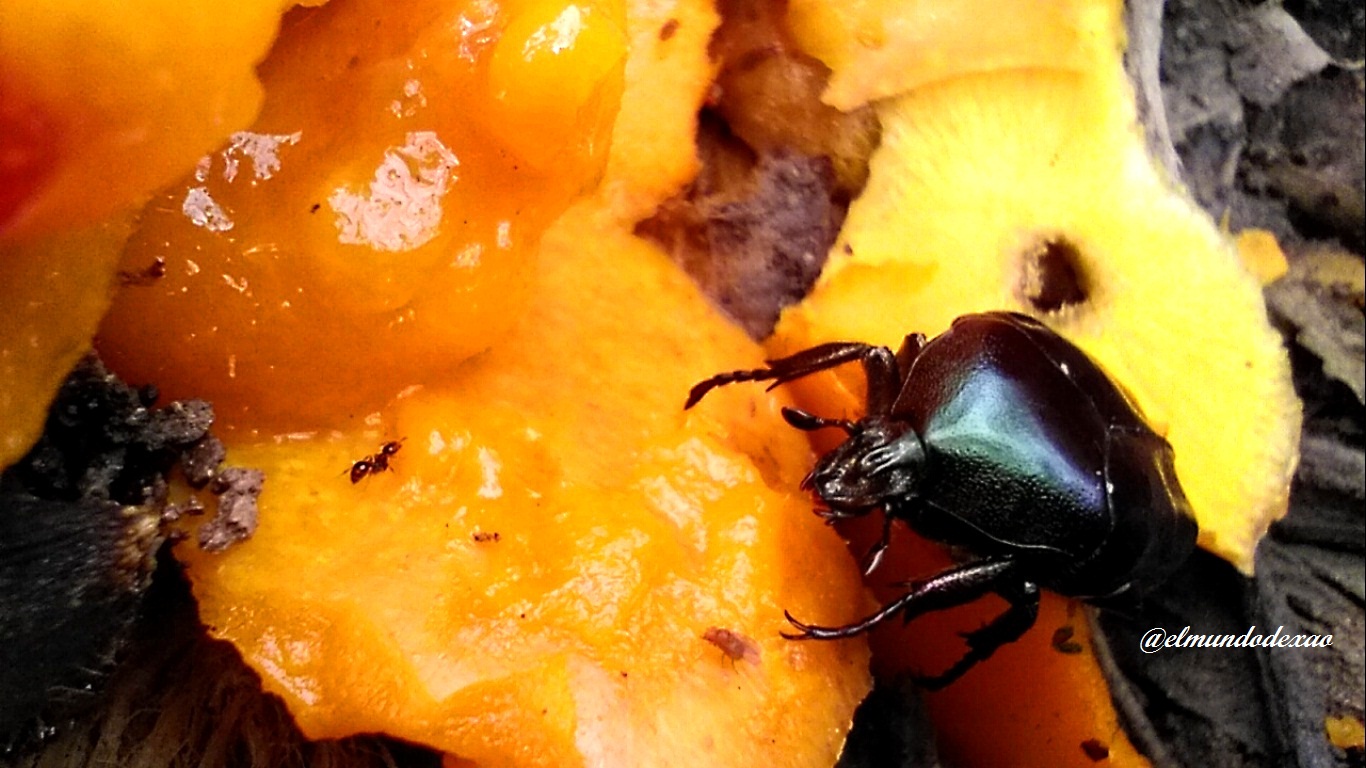
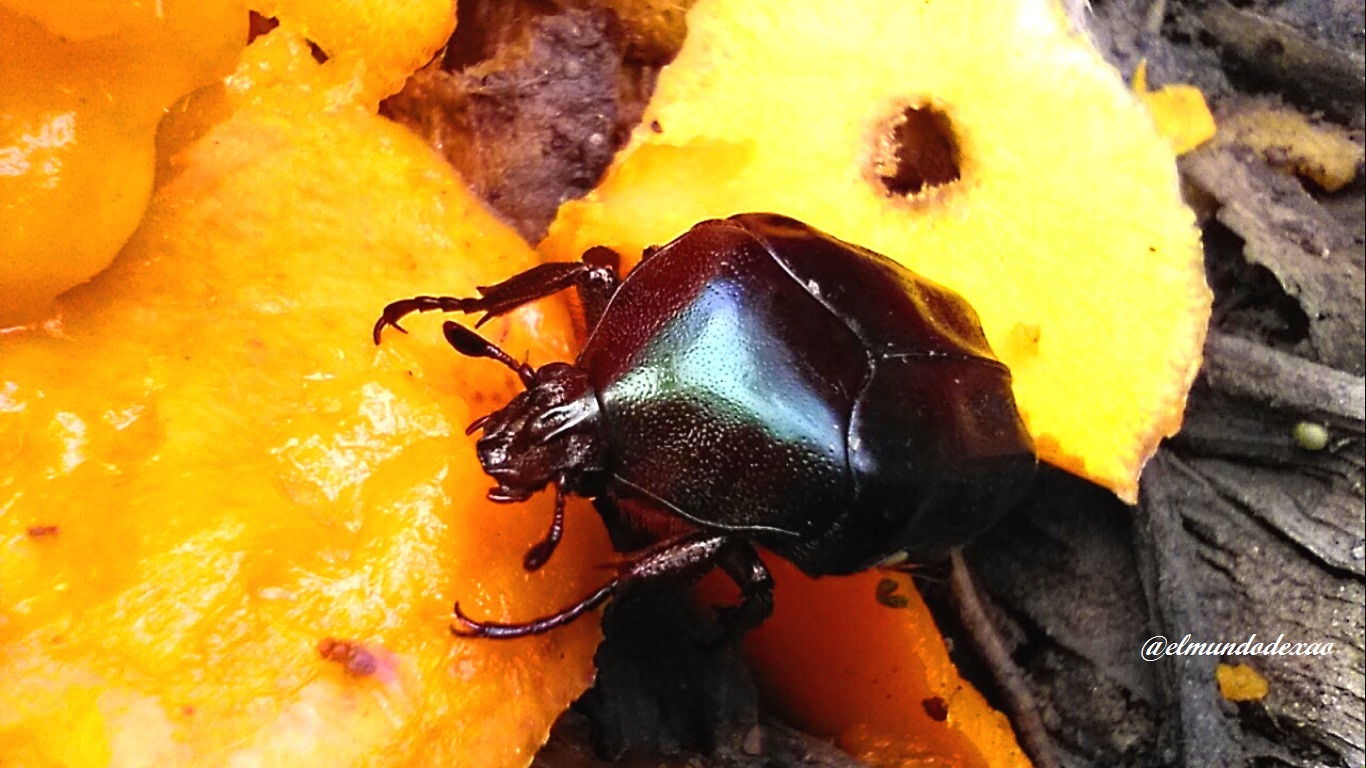
Photo Source: Own photos captured with a Síragon camera.
Modified size: With the Paint Program.
This type of beetle detects odors by means of its antennae, while it is feeding you can observe that it contracts them but these antennae can be deployed as fans to have a greater range of detection. Something quite extraordinary that I have noticed in insects such as beetles, flies and ants is how quickly they can discover the direction where the smell is coming from, it is as if they can see the scent and thus be guided to its source.
Thanks for visiting my Blog… AH! Don't forget to vote, reblogear, and comment.
Translated with:


Hola Hivers.
☺☺☺
Hace unos días me regalaron unos mangos y estaban muy maduros, tanto que su olor era bastante fuerte, por lo que decidimos hacer un jugo y recordé que los escarabajos les gusta lo dulce de las frutas muy maduras, entonces lleve las cascaras al patio con la esperanza de que el olor atrajera algún tipo de insecto para fotografiarlo.

 Al cabo de un rato vimos un insecto volador dando vueltas en ese lugar, todos coincidimos que era un avispón verde de esos que son peligrosos y arrojan una sustancia irritante por el aguijón, por lo que procedimos con cautela acercarnos ya que si en realidad era uno de esos no podríamos acercarnos por obvias razones.
Al cabo de un rato vimos un insecto volador dando vueltas en ese lugar, todos coincidimos que era un avispón verde de esos que son peligrosos y arrojan una sustancia irritante por el aguijón, por lo que procedimos con cautela acercarnos ya que si en realidad era uno de esos no podríamos acercarnos por obvias razones.

 Muchos insectos son atraídos por la melaza o dulce de frutas en descomposición por lo que era casi seguro que tendría alguna foto para mi publicación; cuando nos acercamos logramos ver que no se trataba de un avispón verde sino de un escarabajo traslucido que yo nunca había visto por lo que me emocione mucho, comencé a sacar algunas foto pero mis padres me comentaron que no me acercara tanto porque este tipo de escarabajo no son como los que llegan en las noches a la casa. Este es un escarabajo diurno por lo que es más rápido para volar y es muy desconfiado, en lo que detecta peligro vuela.
Muchos insectos son atraídos por la melaza o dulce de frutas en descomposición por lo que era casi seguro que tendría alguna foto para mi publicación; cuando nos acercamos logramos ver que no se trataba de un avispón verde sino de un escarabajo traslucido que yo nunca había visto por lo que me emocione mucho, comencé a sacar algunas foto pero mis padres me comentaron que no me acercara tanto porque este tipo de escarabajo no son como los que llegan en las noches a la casa. Este es un escarabajo diurno por lo que es más rápido para volar y es muy desconfiado, en lo que detecta peligro vuela.

 Fui acercándome lentamente y al parecer el banquete era demasiado suculento para el escarabajo ya que no me prestó atención en ningún momento, tanto que pude sacar las fotografías en macro y ni siquiera perturbe su momento de satisfacción. Algo que pude notar es que he publicado unos que tienen cuerno, otros con tenazas o mandíbulas fuertes y otros que se caracterizan por tener antenas mucho más grandes que su cuerpo; pero cuando observe este detenidamente me di cuenta que no posee ninguna de estas características. Es decir una de las cosas básicas que debemos aprender es prestar atención a los detalles ya que en infinidades de ocasiones tienen mucha importancia.
Fui acercándome lentamente y al parecer el banquete era demasiado suculento para el escarabajo ya que no me prestó atención en ningún momento, tanto que pude sacar las fotografías en macro y ni siquiera perturbe su momento de satisfacción. Algo que pude notar es que he publicado unos que tienen cuerno, otros con tenazas o mandíbulas fuertes y otros que se caracterizan por tener antenas mucho más grandes que su cuerpo; pero cuando observe este detenidamente me di cuenta que no posee ninguna de estas características. Es decir una de las cosas básicas que debemos aprender es prestar atención a los detalles ya que en infinidades de ocasiones tienen mucha importancia.


Fuente de Fotos: Propias capturadas con una cámara Síragon.
Modificado el tamaño: Con el Programa Paint.
Este tipo de escarabajos detecta los olores mediante sus antenas, mientras se está alimentando se puede observar que las contrae pero estas antenas pueden ser desplegadas como abanicos para tener un mayor rango de detección. Algo bastante extraordinario que he notado en insectos como escarabajos, moscas y hormigas es lo rápido que puede descubrir la dirección de donde viene el olor, es como si pudiesen ver el aroma y así guiarse hasta su fuente.
Gracias por visitar mi Blog… ¡AH! No se olvide de votar, rebloguear y comentar.


















Ahh you love insects ,well for you
Hi @tagmout, that's right I love nature.

Great me too I love thé nature but not insects, sorry for that. Even I know they are essentiel to thé nature to and thé life.